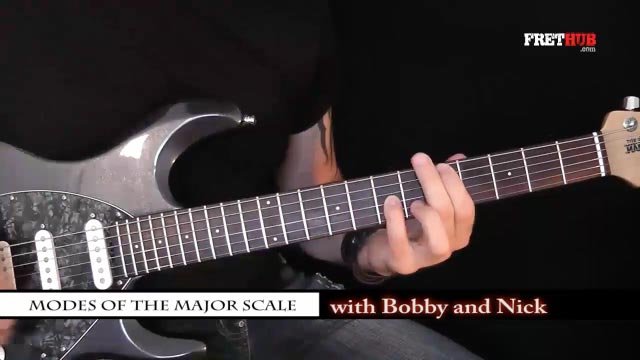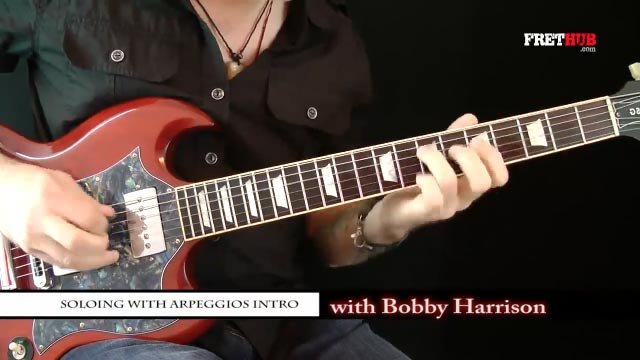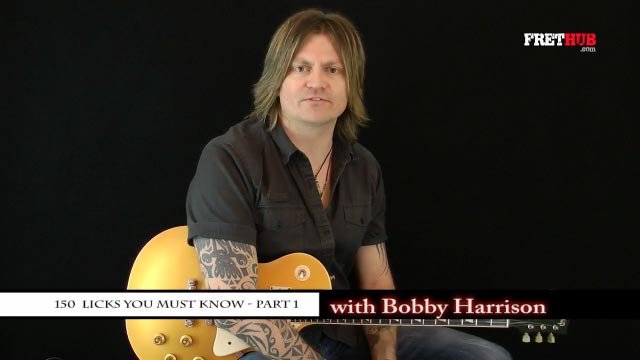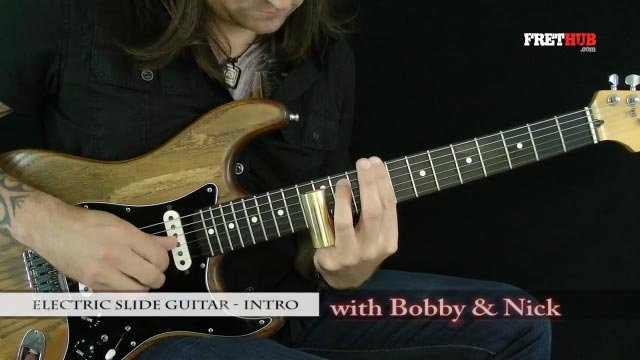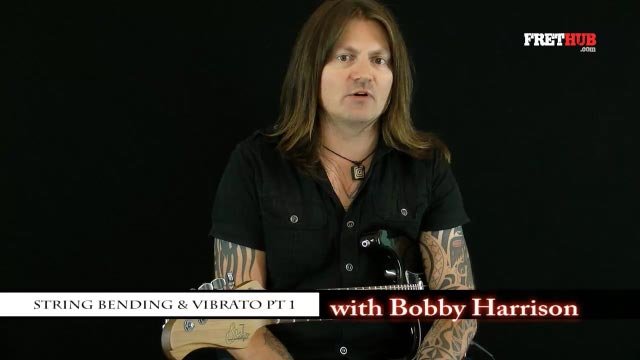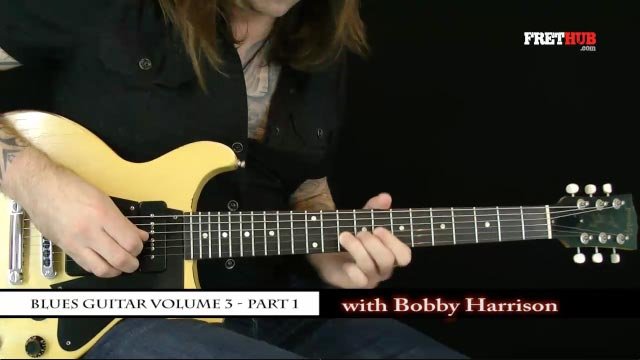If the concept of Modes seems like a mystery to you, this series of lessons will give you a deep understanding of the modal system. If you already know the major scale, there’s a strong chance you may have already been using some of its modes without even knowing it.
You might have heard the names: Ionian, Dorian, Phrygian, Lydian, Mixolydian, Aeolian and Locrian. If not, you will certainly have heard their sounds on many popular songs. These are the modes of the major scale and although there are other more exotic modes from other scales, these seven are the most commonly used in modern music.
Learning how to use the modal system will open up a whole new realm of musical creativity.
Everything you ever wanted to know about arpeggios, but were afraid to ask! This mammoth series of lessons spans 33 videos and weighs in at over 5 hours of great guitar tuition!
FretHub presents an in-depth study on spicing up lead breaks using arpeggios and locating chord tones. Learn the CAGED shapes for major, minor, diminished, major 7th, minor 7th, dominant 7th & minor 7 flat 5 arpeggios, allowing you to solo freely all over the neck. The series of lessons also covers arpeggio substitution, 2 note-per-string arpeggio shapes, string skipping ideas, David Gilmour-esque mini-sweeps, funky rhythm guitar playing and if that wasn’t enough, Bobby finishes by teaching you how to play the solo from the introduction video!
The title says it all. A massive 5 hours of classic rock licks to add to your arsenal! You will have heard some of these licks on many a famous rock album. Now you can see how it’s done! We break down and explain in detail all of the tricks used to play a vast amount of licks. These licks form the foundation of most blues/rock-based guitar playing, so the techniques you’ll learn here will prove invaluable for creating new ideas and solos.
The definitive guide to funk guitar playing. In this 7-part series of lessons, Nick demonstrates a wealth of valuable techniques and ideas for both classic and modern funk.
Regardless of your playing style, you’re likely to find yourself performing a funky rhythm guitar part at some point in your musical future. This comprehensive module will teach you of all the common chord voicings, inversions and techniques used on popular funk records by artists ranging from James Brown to The Red Hot Chili Peppers.
You will learn groove-based vamping ideas made popular by Nile Rogers of Chic, as well as developing other crucial skills, such as leaving space and locking in with your bass player and drummer.
Nick also teaches you rhythmic strumming and muting techniques; choppy, percussive single-note lines; how to use fills in your riffs; tips for applying dynamics and even some blues-based 12-bar ideas.
If you want to take your rhythm guitar playing to the next level, this series of videos is for you.
The definitive slide guitar course.
In this series of lessons, Bobby and Nick introduce you to a wealth of slide guitar licks and techniques. You’ll learn all the fundamental muting and vibrato techniques found in slide playing, as well as some bluesy solos in Open E and Open G tunings, plus some great, rockier ideas in Standard tuning.
As well as providing you with advice on which type of slide to use, how to have your guitar set up for slide playing and teaching you an arsenal of slide licks, Bobby and Nick break down entire blues solos, further increasing your slide guitar vocabulary. Additionally, you’ll learn some great chord ideas, hammer-ons and harmonica-like rolls using the slide, as well as some wild, tapped-harmonic slide ideas.
This course is a must for anybody looking to add slide playing to their list of guitar skills.
A comprehensive study into the techniques of string bending and vibrato.
This stand-alone course serves as a valuable refresher of these two essential techniques. Bobby demonstrates different types of finger vibrato, as well as showing you how to achieve sweet, singing vibrato, using the whammy bar.
String bending is also covered in great depth, as Bobby provides you with all the essential tools to be able to pull off this technique with the minimum of effort. You’ll learn some cool bluesy-rock licks too!
A must for anybody new to the techniques of string bending and vibrato, as well as the player looking to refine his or her technique.
A MUST for fans of both classic and modern Blues.
In this, the first volume of FretHub’s new Blues Guitar series, Bobby takes you through the many variations of the classic Blues Shuffle groove, teaching you how to solo authentically in a blues jam environment as well as playing some tasteful rhythm guitar parts.
There’s a great 48-bar solo to learn, featuring many essential blues licks and techniques, plus some valuable restriction and phrasing exercises, enabling you to build up your soloing vocabulary using just a small area of the neck.
You’ll also learn how to build solos using a more lyrical approach, as well as some great ideas for using chord tones in your lead breaks. This is a comprehensive, 15 part video lesson series not to be missed.
In this series of lessons, we’re going to be focusing on soloing over a slow blues.
You’ve probably heard this kind of playing if you’re familiar with songs such as “Red House”,”Texas Flood”, “How Blue Can You Get”, “Be Careful With A Fool”, “The Sky Is Crying”, “Five Long Years”…the list goes on.
Slow blues is a very expressive form of blues, since it allows for a lot of freedom in terms of phrasing and dynamics.
Since the blues is an improvisational form of music, it’s harder to teach than some other styles. For generations, blues musicians have picked up licks and soloing ideas from other players, so feel free to use the ideas presented here in your own solos. Eventually, like the generations of blues guitarists before you, you’ll make them your own.
As Bobby mentioned in Volume 1, in order to play blues, you need to be able to hear blues and in order to hear it, you need to listen to a lot of it. The ingredients are pretty straight forward in terms of the scales and chords used, but there’s so much more to this form of music in terms of feel, taste, phrasing and expression.
Again, put together a play list of your favourite blues songs and listen to it as much as you can to really internalise the style.
Recommended listening for slow blues:
Stevie Ray Vaughan – “Texas Flood”
B.B. King – “Live At The Regal” & “Live At Cook County Jail”
Albert King – “Blues At Sunrise” & “Blues At Sunset”
An essential study to help take your blues playing to the next level!
This 14-part series of lessons is the third instalment of our Blues Guitar series. We’ve learned how to solo over both a shuffle groove and a slow blues progression, but now it’s time to turn our attention to minor blues playing.
The focus here is how to solo over minor or minor 7th chords, as opposed to the dominant 7th progressions we’ve grown accustomed to. There are several differences in both mood and note choice, especially since we no longer have the luxury of mixing both the major and minor pentatonic scales; and as for our old friend, the major third, avoid that fella like the plague when soloing over a minor blues progression!
We will learn a mean 36-bar solo, containing countless blues licks that you can incorporate into your own playing, as well as a cool, ZZ Top inspired minor blues rhythm guitar part. Bobby also shows us scale, arpeggio and chord-tone ideas for soloing over a minor blues progression.


